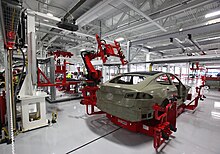
Production managers have referred to them as the “Five M’s”: men, machines, methods, materials, and money.
When viewed as a process, a production system may be further characterized by flows (channels of movement) in the process: both the physical flow of materials, work in the intermediate stages of manufacture (work in process), and finished goods; and the flow of information and the inevitable paperwork that carry and accompany the physical flow.
In some industries, adjustment of capacity is a very difficult task. Assembly lines with specialized equipment, for example, are most efficient when run at one speed and cannot be slowed down or run intermittently without severe economic losses.
There are systems such as electronic circuits, automated production equipment, or robots that may operate in a completely determinate fashion. At the other extreme, there are management and control systems, for both business and military purposes, in which machines in a sense do most of the work but with human supervision and decision making at critical points.
It is a common procedure in science (and elsewhere) to list all the factors that might affect a given situation and select from the complete list those that appear critical.